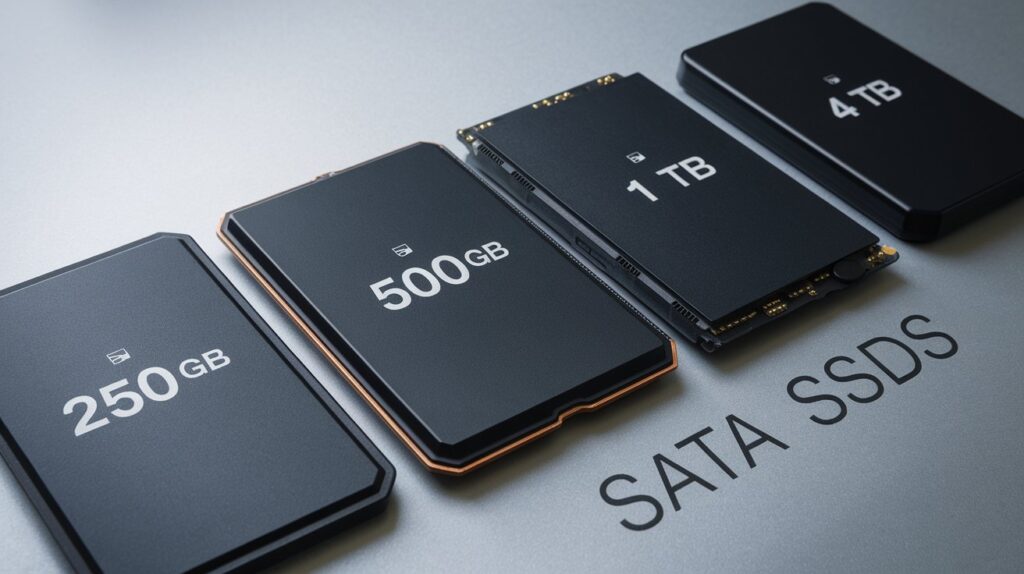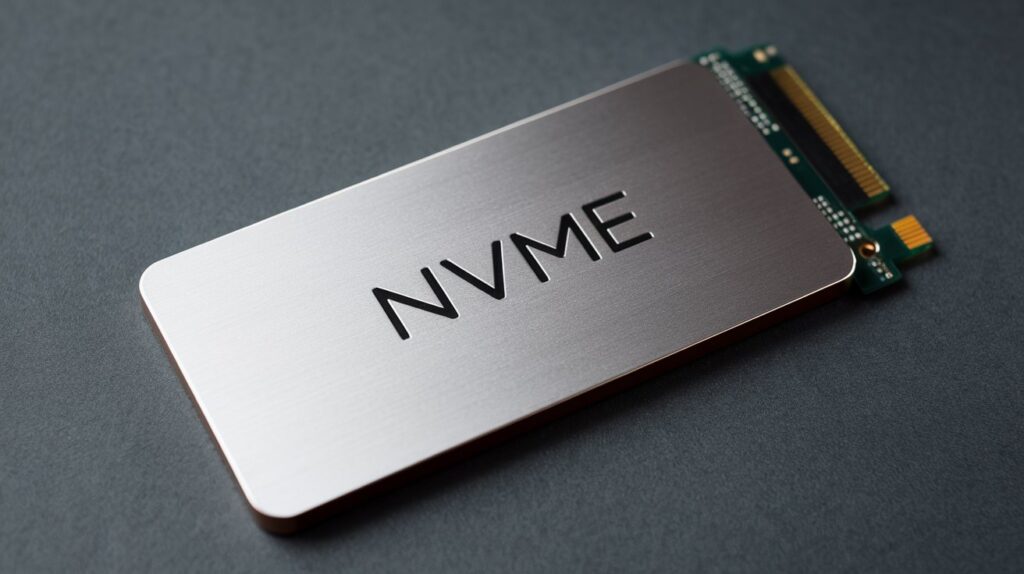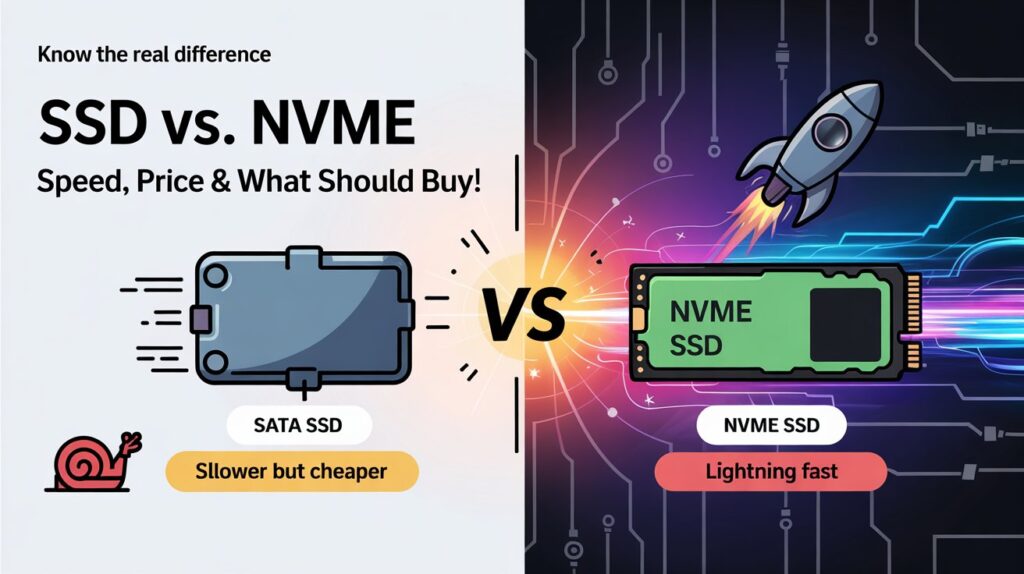If you’ve ever opened up your computer settings or looked at storage upgrade options, chances are you’ve seen terms like SSD and NVMe. And if you’re like most people, you’ve probably asked: Aren’t they both the same thing? Not exactly.
Let’s break it down in plain English—no tech jargon overload, just the real story behind these two storage options. By the end of this article, you’ll know what SSD and NVMe are, how they’re different, and most importantly, which one is the better pick for you.
Understanding the Basics: SSD and NVMe Explained
What is an SSD?
SSD stands for Solid State Drive. It’s a type of storage device used in computers and laptops to store your files, apps, games, and operating system. Unlike old-school hard drives (HDDs) with spinning disks, SSDs have no moving parts. This means:
- They’re faster
- More reliable
- Use less power
- And they’re much quieter
SSDs use something called NAND flash memory to hold your data. You might have seen terms like 2.5-inch SSD, mSATA, or M.2 SATA—these all refer to the shape and type of connection it uses.
If you’re switching from an HDD to an SSD, you’re going to feel like you’ve gone from a bicycle to a motorbike. That’s how big the speed upgrade is.
What is NVMe?
Here’s where things get a little more interesting. NVMe is not a type of SSD—it’s actually a protocol, which is basically the language a drive uses to talk to your computer.
NVMe stands for Non-Volatile Memory Express. It’s designed to work with PCIe (Peripheral Component Interconnect Express) connections, which are much faster than the older SATA connections used by traditional SSDs.
So when people say “NVMe SSD”, they’re talking about a solid-state drive that uses the NVMe protocol over a PCIe connection. It’s a newer, faster kind of SSD—and it’s quickly becoming the gold standard for high-performance storage.
Interface and Protocol Differences
To really understand the difference between SSD and NVMe, you need to look at how they connect to your system.
SATA SSDs

- Use the SATA interface (older tech)
- Max out around 550MB/s read/write speed
- Work great for general tasks like web browsing, streaming, office work
NVMe SSDs

- Use PCIe lanes (modern, faster connection)
- Can hit speeds of 3,000MB/s to 7,000MB/s, depending on the generation (Gen 3, Gen 4, or Gen 5)
- Ideal for gaming, content creation, and multitasking
Performance Comparison
So, how much faster is NVMe? Let’s look at some typical numbers:
| Drive Type | Read Speed | Write Speed |
|---|---|---|
| SATA SSD | ~550 MB/s | ~500 MB/s |
| NVMe Gen 3 | ~3,500 MB/s | ~3,000 MB/s |
| NVMe Gen 4 | ~7,000 MB/s | ~5,000 MB/s |
| NVMe Gen 5 | ~12,000 MB/s | ~11,000 MB/s |
You’re not just getting double or triple the speed—you’re getting 6x to 10x faster speeds with NVMe.
Real-World Impact:
- Boot time: With a SATA SSD, your PC might boot in 15 seconds. NVMe can do it in under 5 seconds.
- File transfer: Copying a 20GB video file? A SATA SSD may take 40 seconds. NVMe might finish in under 10.
- Gaming: NVMe helps reduce load times significantly—great for open-world games or massive texture packs.
Price Comparison: Is NVMe Worth the Extra Cost?
When SSDs first came out, they were crazy expensive. Today, SATA SSDs are quite affordable, and even NVMe drives have dropped in price.
Here’s a quick comparison:
| Storage Type | Price Range (per GB) |
|---|---|
| SATA SSD | $0.06 – $0.10 |
| NVMe Gen 3 | $0.08 – $0.12 |
| NVMe Gen 4+ | $0.10 – $0.20+ |
If you’re on a budget, a SATA SSD still offers amazing value for daily use. But if you want top-tier speed and performance, spending a little extra on an NVMe SSD is totally worth it.
Form Factors and Compatibility
Let’s talk about form factors—that’s just a fancy term for the shape and size of the drive.
SSDs come in:
- 2.5-inch SATA SSD: Looks like a small flat rectangle, connects with a SATA cable
- mSATA: Older laptops sometimes use this
- M.2 SATA: Same size as NVMe M.2 but uses SATA interface
NVMe comes in:
- M.2 NVMe: Thin and long, plugs directly into the motherboard
- U.2 NVMe: Found in high-end desktops and servers
- PCIe add-in card: Looks like a graphics card, installed in PCIe slots
⚠️ Compatibility Tip:
Not all M.2 slots support NVMe! Some only support SATA. Always check your motherboard specs before buying.
Installation: Plug and Play or a Little Setup?
SATA SSDs are usually plug-and-play. Just plug in the SATA cable and power cable, and you’re good to go.
NVMe SSDs, especially M.2 drives, need:
- A compatible M.2 slot (with PCIe support)
- Sometimes a BIOS update
- Optional driver installation for full optimization
But don’t worry—it’s not rocket science. A quick YouTube tutorial can walk you through it in 5–10 minutes.
Pros and Cons Summary
Here’s a side-by-side view to make things easier:
| Feature | SATA SSD | NVMe SSD |
|---|---|---|
| Interface | SATA | PCIe |
| Max Speed | ~550MB/s | Up to 12,000MB/s |
| Price | Lower | Higher |
| Compatibility | Older and newer systems | Newer systems only |
| Boot Time | Fast | Faster |
| Best Use Case | Everyday tasks, upgrades | Gaming, editing, multitask |
Busting Some Common Myths
Let’s clear up a few things you might have heard:
- Myth #1: All SSDs are NVMe
❌ Nope. NVMe is just a type of SSD. Not all SSDs are NVMe. - Myth #2: NVMe boosts game FPS
❌ Not really. NVMe improves load times, not frame rates. Your GPU handles FPS. - Myth #3: M.2 always means NVMe
❌ False again. There are M.2 SATA SSDs too. Always check the label.
Use Case Guide: Which One Should You Choose?
Here’s a simple guide depending on what kind of user you are:
Everyday User (Web, Office, Light Use)
Pick: SATA SSD
You’ll get fast boot times and snappy performance without spending much.
Gamer or Power User
Pick: NVMe (Gen 3 or Gen 4)
Games load faster, and multitasking is smoother—especially if you stream or record.
Content Creator / Editor / Developer
Pick: NVMe (preferably Gen 4 or higher)
Big file transfers, video editing, rendering—all benefit from NVMe’s speed.
Older PC Upgrade
Pick: SATA SSD
Great for breathing new life into an old laptop or desktop. Just make sure there’s a SATA port.
What’s the Future of SSDs and NVMe?
- NVMe Gen 5 drives are already here, reaching speeds above 12,000MB/s
- SATA SSDs will still be around for budget users, but NVMe is becoming the new normal
- As prices fall, NVMe drives may replace SATA SSDs entirely in a few years
- More laptops and desktops now come with NVMe pre-installed
FAQs
1. Can I use both SSD and NVMe in the same computer?
Yes! As long as your motherboard supports both, you can have a SATA SSD and an NVMe SSD working together.
2. Is NVMe worth it for gaming?
For faster loading and game installations—absolutely. But don’t expect a boost in FPS.
3. Can NVMe work in all laptops?
Nope. Some laptops only support SATA SSDs. Check your manual or search your model online.
4. Is SATA SSD fast enough for daily use?
Totally. It’s way faster than an old hard drive and perfect for most people.
5. How do I know if my SSD is NVMe?
Check the specs in your system settings or use tools like CrystalDiskInfo. NVMe drives often show up under PCIe interfaces.
Final Thoughts
Let’s be real—any SSD is better than an HDD. But if you want the absolute best speed your system can handle, NVMe is the clear winner.
Still, not everyone needs lightning-fast storage. So here’s the takeaway:
👉 If you’re upgrading from an HDD—SATA SSD is a game-changer
👉 If you want peak performance for gaming, editing, or multitasking—go NVMe
👉 And if you’re building a new PC—future-proof with NVMe if your motherboard supports it
No more confusion—just smart storage choices.
Ready to upgrade your storage? Let us know in the comments below:
Are you going with SATA SSD or diving into the world of NVMe speed?

